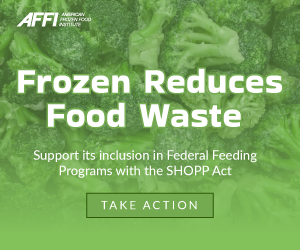By Anne-Marie Roerink, President, 210 Analytics, LLC 
The Many Dimensions of Food Waste
The importance of and interest in curbing food waste is rising for many reasons. The American Frozen Food Institute (AFFI) and 210 Analytics teamed up to understand the attitudes, drivers and solutions surrounding food waste through a survey conducted in September 2022 among 1,548 consumers. The full findings are available online.
Food waste has long been a source of irritation and concern, according to 88% and 87% of consumers, respectively. This includes seeing food being wasted in the supply chain or having food go to waste in their own kitchens. Amid 43-year high inflation, economic pressure is another important driver to look into ways to curb food waste, according to 77% of consumers who say they cannot financially afford to discard food. This share rises to 85% among low-income, SNAP-eligible consumers to whom the financial impact of food waste is the highest among all cohorts. The impact on the planet is a third important reason, with 81% of consumers being concerned about the environmental impact of food going to waste at any point in the supply chain. The environmental impact of food waste is of elevated concern among younger consumers.
The Freezer to the Rescue
When looking into solutions to curb food waste, the freezer is high on the radar. According to the survey:
- 91% of consumers believe freezing leftovers is a good way to reduce food waste.
- 91% believe that freezing foods is a good way to save money. In fact, 86% of Americans buy food in bulk with the purpose of freezing it to use over time, especially meat (81%), chicken (74%), vegetables (50%), seafood (42%) and fruit (36%).
- 83% agree that buying frozen food is a good solution to limit the amount of food waste for their households and 84% believe it also helps saves money.
Food Waste Reduction Attributes
Frozen food’s longer shelf life contributes to the consumer-reported attributes that reduce at-home food waste. The majority of shoppers (79%) report that the ability to take out and prepare exact portions is a purchase driver for frozen food ingredients, such as frozen fruits, vegetables, seafood and meat. The core consumers of frozen, who are high-frequency shoppers, are more likely to rate the ability to portion out exactly how much is needed as an overriding purchase driver that may outweigh other product attributes.
Additionally, when trying to combat fresh food waste, 77% purchase their frozen counterpart on occasion. Consumers also give high marks to the flexibility of frozen food ingredients. According to the survey, having frozen food ingredients on hand has many perceived benefits, such as:
- Taking away concern of food spoiling before having a chance to eat it (92%).
- Allowing for preparing a quick meal at home instead of purchasing restaurant food (91%).
- Providing flexibility in taking out the exact portion needed for the meal and prevent cooking too much (89%).
Opportunities to Improve
Given the financial, economic and environmental impact of food waste, every link of the food supply chain is looking into solutions. This includes improvements in packaging, such as vacuum packages that prevent freezer burn, shelf-life technologies that extend the life of fresh fruits and vegetables, as well as investment in more frozen by retailers and consumers alike.
Since the onset of the pandemic, 30% of Americans have expanded their freezer capacity at home, whether an additional fridge/freezer combination or a chest freezer. More freezer capacity goes hand-in-hand with consumers freezing items at home more frequently as well as purchasing items from the frozen food department more often and across more categories. In turn, these shoppers use frozen foods across more meal occasions, ranging from breakfast and dinner to snacks and beverages.
In-store, stand-alone freezers are delivering flexibility to retailers to cross-merchandise and bring frozen food solutions into other areas of the store to drive additional trips. Others are adding doors and assortment to the frozen food aisle and experimenting with cross-merchandising different meal items copying the success of meal solutions in the fresh departments. As many consumers add extra toppings to pizza, why not cross-merchandise frozen chopped bell peppers, diced onions and sliced mushrooms right next to frozen pizza?
The opportunities to deliver convenience with frozen foods while preventing food waste are endless!




